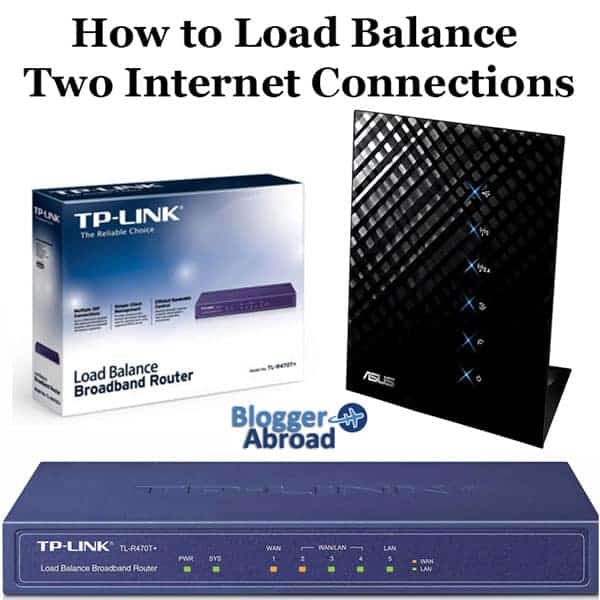How to Load Balance Two Connections (Get Better Internet Abroad)
Stable internet is always a concern. While the internet would go out once in a while in Canada, it was rare and for short periods of time. Living in Ecuador means that internet isn’t as stable as we were used to. In the past few years, we’ve had the internet cut for days at a time.

While this isn’t the end of the world for the average user, it can be painful for our business – and our schedule.
How a Load Balancing Router Will Improve Your Internet
In order to create a more stable connection, I recently had a second internet connection installed. One is cabled and the other is via an antenna outside of our building.
If the main one failed, I just unplugged it and then plugged in the other. This got a little tedious. And obviously didn’t maximize the available resources and bandwidth.
How I Created a Stable Internet Connection
While I had never heard of a way to join two connections into a single, stronger one, I searched for it. What I found is a technology called “load balancing”.
What is Load Balancing? Quick Answer
Load balancing is a computer networking method for distributing workloads across multiple computers or a computer cluster, network links, central processing units, disk drives, or other resources. Successful load balancing optimizes resource use, maximizes throughput, minimizes response time, and avoids overload. (Courtesy of Wikipedia)
Essentially, a load balancing router takes multiple incoming internet connections (WAN – wide area network) and combines them into a single, strong connection (LAN local area network). A broadband router with multiple WAN ports is needed.
I found lots of expensive (and heavy) options. Prices ranged from $170 to over $400 for a router with multiple WAN ports. Weight is a concern, because I had to ship it from the US to Ecuador. And I have a maximum value limit of $400 for individual shipments, according to Ecuadorian Customs.
My Load Balancing Router
The router I ended up buying is the TP-LINK TL-R470T+ (5-port Load Balance Broadband Router, 3 Configurable WAN/LAN ports, 1 LAN, 1 WAN). What this description means is that there are a total of 5 ports:
- 1 dedicated WAN port
- 1 dedicated LAN port
- 3 ports that can be configured to either WAN or LAN.
I used the dedicated WAN port and one of the configurable ports as a WAN port as well. So I have two incoming internet connections that then feed a single connection across the three remaining LAN ports. I directly wired two of our computers into the LAN ports. The remaining LAN port feeds my ASUS Dual-Band AC2900 Router.
Back then, the cost was around $65 (product plus shipping to Ecuador). Although TP-LINK isn’t a high-end brand, I thought it was worth a try. My biggest concern was configuring it.
Configuring the Load Balancing Router
One of the biggest complaints for this type of router is how difficult they are to configure. Many online reviewers said they just had to return their router because they couldn’t make it work.
When it first arrived, I set it aside because I thought I would need hours to get it setup. I was afraid to change configurations of the current modem/router – and be left with nothing working.
Well, one night I got a burst of blind confidence and in less than 10 minutes the router was functioning and blending (load balancing) my two connections. When it was finished, I couldn’t believe how easy it was.
Just follow the four steps in the printed guide and you’ll be good to go. Now my connection should almost never fail (because if one cuts, all the traffic automatically switches to the other one). And my bandwidth has increased significantly – even at night when the internet usage is extremely high.
Simpler Option for Load Balancing (All in One)
Since I first set this up, technology has improved and you can purchase a router with built-in load balancing. This makes configuration much easier.
I currently have an Asus gaming router (but I’m not a gamer). It is high-end gear and super easy to set up. It is almost just plug-and-play.
Check current price of Asus router on Amazon
The unit automatically combines two internet connections – giving you more stability and bandwidth.
Why the Internet is Slow and Unstable
There are a number of factors working against you.
Power cuts: In many countries, the power grid is not very stable. It doesn’t take much to knock it out for hours (sometimes days) at a time. When we first moved to Ecuador we would frequently have periods (4-14 hours) without power. Other times we would have power but no internet – because their main hub was without power.
- Sharing connections: While your internet connection might be passable during the day, it will often grind to a near halt at night. It seems that everyone goes online around 7pm until midnight. Because of one connection being shared between up to eight households, the internet often becomes almost unusable in the evening (and during holidays / Sundays).
- Poor administration: We’ve had our connections disconnected by our internet service provider many times. When I called to see what happened, they told me that we didn’t pay for that month. Of course, we did pay – they just didn’t have a proper system in place to track payments. This has happened with multiple providers – multiple times.
How to Have Fast and Stable Internet Abroad
To get around this, we have two permanent connections: one cabled and one via an antenna. They are different companies with distinct delivery methods. We also have a USB modem in case of an emergency.
Regardless of the issues, we almost always have an internet connection. When one provider is out, we can use the other one. Because of our UPS (uninterruptible power supply) we can manage any brief power outages without losing the connection. The weakest link in our system is that we don’t have a generator. Once we pass the 40-minute mark, our UPS runs out of juice and we are reduced to paper…
For a while, we had to manually switch between connections when one went out. While it worked, it wasn’t ideal.
Then we discovered load balancing.
What is Load Balancing?
Load balancing is a method for sharing (balancing) workloads and bandwidth across multiple connections. I’ve heard that there are web services and programs that will do this. We just purchased a load balancing router that does it automatically.
The setup was simple and straightforward. (See above) To make it work, we just feed our two connections into the router and then it combines them into one, stronger connection. I then connect the load balancing router to my main wireless router to distribute the signal throughout the house.
While there are lots of options, the load balancing router we use is the TP-LINK TL-R470T. It cost around $50 and was well rated. While the brand isn’t a premium one, I am very happy with this purchase. We’ve been using this for more than a year without any issues.
3 Benefits of Using a Load Balancing Router
If you set up two connections that are then load-balanced into one, you’ll see several immediate benefits:
- More Stable: This is significant. If one connection goes out (and it will), you won’t lose your connection. You will continue to send/receive data through your remaining live connection.
- Higher Speed: You get the combined upload/download speeds of the two connections. Many areas still offer just entry-level speeds. The only way to increase this is to combine two connections.
- More Bandwidth: I saw dramatic improvements in large file uploads with the combined connections. Especially videos to YouTube (200-500mb).
Final Thoughts
It’s been two weeks with the router and I love it. I can’t believe I went the last four years living in Ecuador without it.
If you live abroad – and the internet is important to you – you should consider getting two connections installed and combining them with a load-balancing router.
What has been your experience with the internet abroad? Have you used a load-balancing router?

 Power cuts: In many countries, the power grid is not very stable. It doesn’t take much to knock it out for hours (sometimes days) at a time. When we first moved to Ecuador we would frequently have periods (4-14 hours) without power. Other times we would have power but no internet – because their main hub was without power.
Power cuts: In many countries, the power grid is not very stable. It doesn’t take much to knock it out for hours (sometimes days) at a time. When we first moved to Ecuador we would frequently have periods (4-14 hours) without power. Other times we would have power but no internet – because their main hub was without power.





This comment may save a future user of the TL-R470T (v4 now) some grief.
I bought v1.1 of this router mid 2012 for use in Nicaragua to combine 3 ISP connections & each were lower speeds than yours. It was set up out of the box to “balance by destination”. This meant that your connection to an internet site only used 1 of the 3 ISPs. And the same for other users on your network. Thus it didn’t combine the 3 connections to increase the speed proven by speedtest.net. But it did help because your network users didn’t interfere with each other as much.
I nosed around in the help & learned if you set it to “balance by packet” each packet (little chunk of communicators) to a site uses the best of the 3 ISPs so you sum their speeds. Again proven by speedtest.net.
BUT this is the potential grief: HTTPS (S=Secure) sites like banks usually detect fraud if your internet signals come form more than 1 ISP & they lock you out. You have to jump through the hoops (usually a phone call) to explain the situation & get back in. Same now for HTTPS web mail – yahoo, hotmail … except usually security question or text message.
The solution is to change the balance rules for the HTTPS sites. This router doesn’t require a re-boot like some other so not a big problem.
(Technically IP may be a better word than ISP for describing connections)
Thanks for sharing this John!
Aloha Bryan,
Thank you for the great helpful tips on load balancing and router recommendations. We’re moving to Ecuador in December (and are very excited) but this was extremely helpful since we have two internet businesses.
Mahalo
I build load balancers (L.B.’s) here in Cuenca. They are linux based and much more robust than many of L.B.’s you can buy out of the box. L.B.’s I build include a firewall, DHCP , QOS, failover and much more. As mentioned in this article you will notice improved network performance. Organizations with many computers will greatly enhance overall network performance by utilizing L.B’s. Bryan is correct when he says “the few extra dollars we spend is nothing compared to the saved time and stress” The performance increase and stability is well worth the cost.
I also build linux based media players for home or hotel entertainment. These small devices will allow you to watch virtually any movie, tv-show, youtube, music, news/entertainment channels the internet has to offer. You do not need VPN’s as this box works without regard to which country you are in or from. If your on a slower internet connection you can download movies at night to build up your library and view at a later time. Real time viewing is always best with faster connections. The menu system is elegant and easy to navigate. Contact me should you have questions. joelinux@yandex.com
I am curious: Is this a load-balancing router or does it just switch over to the other connection upon failure of the preferred? Load-balancing routers tend to be quite a bit more expensive than you have quoted. That is why I asked the question.
You can check out the direct link in the post – it is a load balancing router (as the name suggests). 🙂
Under their specifications they say “Load Balance: Policy Routing, Link Backup”. Policy routing is about what to do when a connection fails. What this router does is it fails over to a backup connection when the primary connection goes out. I guess this is picking nits, but that is not load balancing. Load balancing is where some traffic goes out one WAN port and some goes out the other simultaneously. The idea is that you balance the load over two or more connections. As I mentioned before you probably wouldn’t want to pay the cost of a true load-balancing router. I guess I am just a stickler for accuracy. Sorry about that.
I’m not a network expert, but according to Wikipedia, “policy-based routing (PBR) is a technique used to make routing decisions based on policies set by the network administrator.” The definition explains that a policy can include instructions for where a router would “forward it (a packet) based on the destination address in the packet.” There is no mention of connection failures in this entry.
This doesn’t rule out load-balancing – it just means that it is dependent on the policies set by the programmer. Unless I’m understanding this incorrectly?
Yes, based on Cisco and Juniper documentation you can use a policy for load-balancing. But the router you are using may not have this option as part of its policy configuration. You would have to look for such a n option.
Mike, this is a load balancer router. You can bind (not bond) two connections to achieve twice the download speed for say P2P or download managers.
Yes, you maybe correct about P2P as there are multiple sessions involved. So, is feasible one link is used for one session and another link is used for an additional session. But the word POLICY is used to describe the router. All policy-based routers I worked with (e.g., Cisco 7507), used policies to describe a fail-over situation. However, we had load-balancing configurations as well, where traffic was sent over both connections. I don’t know why you would need a policy to describe a load-balancing condition, unless you were telling the router how much traffic to send over one link as opposed to another.
Mike, this router is more beneficial in offices where different users are accessing multiple sites/connections simultaneously thus they will get better internet speed.
HI,
I need to support 150 users and talked with TP-Link they said it can only support 50 users, can anybody suggest me other way of doing it to support 150 users?
I have also setup and installed Dispatch Proxy on windows does it will support 150 users?
Do you use magic jack, OOMA or any other VOIP service other then Skype? I am trying to decide if I am going to bring magic jack or some other VOIP service with me when I arrive.
Do you subscribe to any free or paid service to receive a USA IP address when you surf?
I would like to leave a comment on how helpful your blog is, but I do not know where to click to do this. Can you direct me? Thanks so much. James (Jack) Honeycutt Portland Oregon – Soon to be in Ibarra Ecuador
Sorry for my slow reply. I missed your question.
We only use Skype. Many expats use magic jack but I don’t see the need. I’ve looked into a VPN service, but I’m not using one yet.
All the best on your plans!
What two services do you use to load balance? At what megas and cost? Thanx.
You can combine any two connections. I can’t imagine a connection that this wouldn’t work on. It really depends on your budget and your speed requirements.
Hey man, you mentioned you followed the “four steps in the printed guide”…which steps would those be? Having a bit of trouble with this currently :/
I don’t think I still have it. There was a guide that came with the router. You can download the guide direct from TP-Link. Hopefully this helps.
Forget that question of mine, I just noticed that the second router is wireless. Silly me….
Hi Bryan, Great hack! What i don’t understand is why do you need the second router?
Thanks
You already answered my question…………..Thanks.
Bryan Haines July 4, 2013, 8:14 am
Yes, this means two internet connections. It is really a question of how important a stable connection is. In our case, it is how we work – and the few extra dollars we spend is nothing compared to the saved time and stress.
Does this require 2 separate internet providers/sources or a single provider?
Not quite understanding of the setup of incoming signals.
Thanks.
Excellent timing for me to find this. I am returning to Calif for a week next month, so just ordered this to be waiting for us to bring it back.
I have been using two ISPs (ETAPA and Puntonet — can’t get TVCable in el Centro), each with its own wireless. When one goes down, I just switch to the other wireless network. Bit of a nuisance though, and doesn’t get the speed benefit of tying both together. Your solution sounds much better than what I have been doing!
Nice. Glad that this helped. Let me know how it goes for you.
Thanks for the info. We have TVCable in Quito and its pretty awful, cuts out almost daily. We have CNT as a back up but its just for the VOIP phones. I like the idea of combining the two. We are supposed to get fiber optic in the coming months, we shall see.
It works well for us. Let me know how it goes for you.
We need to maintain a static IP address for our business, is there a way to maintain a static IP address when the load balancing kicks in and we switch from one ISP to another?
I don’t know. This is beyond my knowledge. You might find a good forum with the company to ask that question.
I’ve noticed that our IP address changes multiple times in the day – usually rotating between 2 or 3 specific numbers.
can you email me the steps on how to mixed up the two internet speeds?
thanks
It is actually in the post above. Just setup the load balance router and it will combine both.
Do I have to check or uncheck any of the fields in the load balance option?
Coz mine can’t mix the two internets.
thanks
Hi Bryan. We finally got our internet connection here in Olon after four months. But the biggest pkg that CNT offers in our area is 3MDown/0.5M up. For the job that I want to do, it requires 3M down, and 1M up. CNT can give us a dedicated 1:1 M line for $130 + tax per month. I was wondering if we could install the load balancer and use the combined strength, resulting in 4Mdown/ 1.5M up. Is this what this product does? Although our residential pkg 0f 3M/0.5M can be shared between 8 customers, we are the only people in our neighborhood who have the internet, and the speed test shows that we actually are getting over 3M down and 0.4M up. I just hate to order this item or another internet connection if it is not going to give me the result I need. What is your opinion?
I haven’t done comprehensive speed tests but what you are describing is what a load balancer will do. You can see speed improvements – and the connection will be always-on. And if one connection cuts out – the other one will keep you online.
I also bought a TP-LINK load balancing router. Then I talked to HMA about it: http://hidemyass.com/
After about 6/8 weeks, they decided they liked it. It is suppose to appear on the “approved” list of routers they now support.
I have yet to deploy it. I move to Ecuador this year sometime.
I have the same understanding as Bryan has. You can down load the manual free on line as a pdf file if you want to learn more.
Hi Bryan,
I’m interested with this kind of setup in our office and would like to know more details regarding this. Can I know your Skype ID or would it be ok if you can add me? My Skype ID is hansel.baro. Any help would be very much appreciated. Thanks.
Cheers,
Hansel
Hi Hansel – you are welcome to ask questions via the comment section. I’ll do my best to help.
Alright. I would like to inquire regarding Your Router (TP-LINK TL-R470T+) that supports running 2 ISP at the same time. Basically I need a router to do a Load Balance for our 2 ISP (100mbps and 10mpbs), 0 downtime and increase the bandwidth per user.
My Objectives are the following:
* Increase the bandwidth per user using the combined 2 ISP (100mbps and 10mbps)
* Faster and Stable connection in our office.
* 0 downtime in our office, meaning if 1 ISP shut down the other ISP will support the users to stay connected in the Internet.
* Security features from hackers and viruses using the Built in firewall of this product.
Kindly advise if this is possible with the router you’re talking about. You can also have your preferred setup if you can think of a better setup. Any help is very much appreciated.
Cheers,
Hansel
I don’t have stats to show the increase in speed and bandwidth but yes, this load balancer will do what you are looking for. By combining the 2 connections into one, you will reduce (almost to zero) the possibility of being without a connection. If one fails the other will continue to work.
By sharing incoming and outgoing bandwidth, the 2 connections can’t help but increase your speed – especially for uploads. This is often the limiting factor with ISPs.
I don’t have experience with the security features. I know very little about this.
I See. Last question. Do you think this router can Handle 100 users at the same time? My plan is to use this router using the 2 ISP. then connect it to our swithches for Lan connections and the connect it too for our access points (Unifi) Thanks man.
Cheers,
Hansel
I don’t have experience with that many users at one time. I suppose it would have more to do with what the users were doing online (streaming video or writing emails) than with the number of actual users.
You should be able to contact the TP-Link directly to confirm this detail.
Thanks!
You share valuable information about Cuenca; however, I am coming to Quito. Do you know of a similar service provided by any ex-pat in Quito?
thanks for your consideration,
Luc
No, I haven’t seen one. If you find one, please let me know.
Bryan
Hi… My blu-ray player is smart. It will stream many things to me like Netflicks, and Amazon. My new TV is also smart and will let me surf as well as stream. Both products need to be connected to the internet for BIOS updates.
I was going to use a Proxy server when I move to Ecuador. I was going to use “Hide my Ass”. Is it possible to configure this unit so it will head to Hide MY Ass and display a USA IP address when I go out to the web in the US and watch netflicks and other streaming services?
Thanks
Does the new router have a firewall and DHCP server built-in as well?
Yes. You can read about this specific router here.
According to the product description, here are some of the details:
Thanks
good article … however, this will only work if you have 2 independent internet sources, correct? Which means 2 internet accounts or double your monthly cost … correct? If that is indeed so many of us xpats can not afford the upgrade … if not so, kindly explain … thanks!
David
Yes, this means two internet connections. It is really a question of how important a stable connection is. In our case, it is how we work – and the few extra dollars we spend is nothing compared to the saved time and stress.